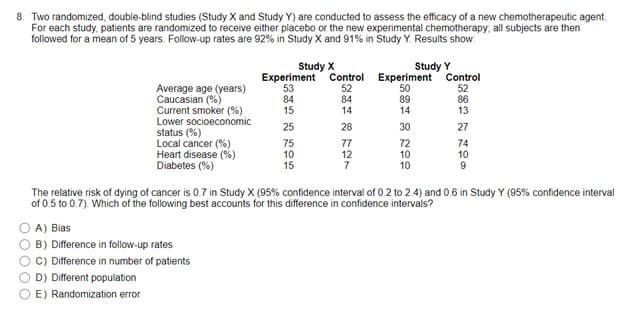8. Two randomized, double-blind studies (Study X and Study Y) are conducted to assess the efficacy of a new chemotherapeutic agent. For each study, patients are randomized to receive either placebo or the new experimental chemotherapy, all subjects are then followed for a mean of 5 years. Follow-up rates are 92% in Study X and 91% in Study Y. Results show 84 Study X Study Y ETITI Lower socioeconomic Average age (years) Caucasian (%) Experiment 53 Control Experiment 52 50 84 89 Current smoker (%) 15 14 14 Control 52 86 13 25 28 30 27 Local cancer (%) Heart disease (%) Diabetes (%) 75 77 72 10 12 10 74 10 15 7 10 9 status (%) The relative risk of dying of cancer is 0.7 in Study X (95% confidence interval of 0.2 to 2.4) and 0.6 in Study Y (95% confidence interval of 0.5 to 0.7). Which of the following best accounts for this difference in confidence intervals? A) Bias B) Difference in follow-up rates C) Difference in number of patients D) Different population E) Randomization error
8. Two randomized, double-blind studies (Study X and Study Y) are conducted to assess the efficacy of a new chemotherapeutic agent. For each study, patients are randomized to receive either placebo or the new experimental chemotherapy, all subjects are then followed for a mean of 5 years. Follow-up rates are 92% in Study X and 91% in Study Y. Results show 84 Study X Study Y ETITI Lower socioeconomic Average age (years) Caucasian (%) Experiment 53 Control Experiment 52 50 84 89 Current smoker (%) 15 14 14 Control 52 86 13 25 28 30 27 Local cancer (%) Heart disease (%) Diabetes (%) 75 77 72 10 12 10 74 10 15 7 10 9 status (%) The relative risk of dying of cancer is 0.7 in Study X (95% confidence interval of 0.2 to 2.4) and 0.6 in Study Y (95% confidence interval of 0.5 to 0.7). Which of the following best accounts for this difference in confidence intervals? A) Bias B) Difference in follow-up rates C) Difference in number of patients D) Different population E) Randomization error
Chapter9: Sequences, Probability And Counting Theory
Section9.7: Probability
Problem 3SE: What is an experiment?
Related questions
Question

Transcribed Image Text:8. Two randomized, double-blind studies (Study X and Study Y) are conducted to assess the efficacy of a new chemotherapeutic agent.
For each study, patients are randomized to receive either placebo or the new experimental chemotherapy, all subjects are then
followed for a mean of 5 years. Follow-up rates are 92% in Study X and 91% in Study Y. Results show
84
Study X
Study Y
ETITI
Lower socioeconomic
Average age (years)
Caucasian (%)
Experiment
53
Control Experiment
52
50
84
89
Current smoker (%)
15
14
14
Control
52
86
13
25
28
30
27
Local cancer (%)
Heart disease (%)
Diabetes (%)
75
77
72
10
12
10
74
10
15
7
10
9
status (%)
The relative risk of dying of cancer is 0.7 in Study X (95% confidence interval of 0.2 to 2.4) and 0.6 in Study Y (95% confidence interval
of 0.5 to 0.7). Which of the following best accounts for this difference in confidence intervals?
A) Bias
B) Difference in follow-up rates
C) Difference in number of patients
D) Different population
E) Randomization error
AI-Generated Solution
Unlock instant AI solutions
Tap the button
to generate a solution
Recommended textbooks for you

